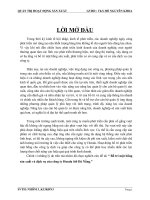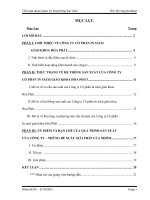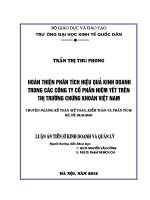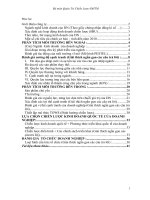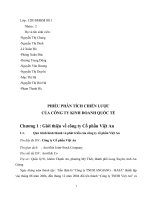An investigation in building business strategy - the case of Nam A Company = Nghiên cứu xây dựng chiến lược kinh doanh - trường hợp công ty cổ phần xây dựng và sản xuất Nam Á
Bạn đang xem bản rút gọn của tài liệu. Xem và tải ngay bản đầy đủ của tài liệu tại đây (1.68 MB, 83 trang )
VIETNAM NATIONAL UNIVERSITY, HANOI
SCHOOL OF BUSINESS
TRINH LAN HUONG
AN INVESTIGATION IN BUILDING BUSINESS STRATEGY
– THE CASE OF NAM A COMPANY
Major: Business Administration
Code: 60 34 05
MASTER OF BUSINESS ADMINISTRATION THESIS
Supervisors: Tran Doan Kim, PhD
Ha Nguyen, MBA
Hanoi - 2012
vi
TABLE OF CONTENT
ACKNOWLEDGEMENTS i
ABSTRACT ii
TÓM TẮT iv
TABLE OF CONTENT vi
LIST OF TABLE ix
LIST OF FIGURE x
LIST OF CHART xi
INTRODUCTION 1
1. Problem statement 1
2. Paper objectives 1
3. Research question 2
4. Methodology 2
5. Significance 2
6. Limitation 3
7. Thesis structure 3
CHAPTER 1: THEORETIC FOUNDATION 4
1.1 Strategy and strategic management 4
1.1.1 Definition and levels of strategy 4
1.1.2 Business strategies 5
1.1.3 Strategic management process 9
vii
1.1.4 The role of strategic management 10
1.1.5 Strategic decision making 11
1.2 Analysis models 12
1.2.1 PESTLE model 12
1.2.2 Five-force model 14
1.2.3 Value chain model 17
1.2.4 SWOT model 18
CHAPTER 2: INTERNAL AND EXTERNAL ANALYSIS 20
2.1 External analysis 20
2.1.1 Background information 20
2.1.2 Environmental scanning and forecasting – PESTLE analysis 27
2.1.3 Industry analysis – Five-Force model 40
2.2 Internal analysis 46
2.2.1 Nam A Company profile 46
2.2.2 Value chain analysis 48
2.3 External and internal analysis summary – SWOT analysis 58
CHAPTER 3: STRATEGY RECOMMENDATION 61
3.1 Strategy formulation 61
3.2 Strategy implementation 63
3.2.1 Cost leadership by cutting organization structure 65
3.2.2 Cost leadership by improving material using efficiency 67
3.2.3 Cost leadership by improving stage transfer efficiency 68
3.2.4 Cost leadership by improving asset utilization 70
viii
3.2.5 Cost leadership by gaining access to lower-cost materials 71
3.2.6 Cost leadership by maintaining low warehousing and marketing costs 72
CONCLUSION 73
REFERENCE 74
ix
LIST OF TABLE
Table 2.1: Construction growth in percentage from 2005 to 2012 32
Table 2.2: Comparison of doors and windows’ characteristics 42
Table 2.3: SWOT analysis of Nam A Company 60
Table 3.1: Comparison of typical strategies in the case of Nam A Company 62
Table 3.2: Function strategies for Nam A Company 64
x
LIST OF FIGURE
Figure 1.1: Porter’s Generic Competitive Strategies 6
Figure 1.2: Strategic management process 9
Figure 1.3: PESTLE model 13
Figure 1.4: Five-force model 15
Figure 1.5: Value chain model 17
Figure 1.6: SWOT model 19
Figure 2.1: Vietnam uPVC doors and windows industry life cycle 21
Figure 2.2: Correlation between product quality and price of fragmentation
group in the industry 27
Figure 2.3: UPVC door and window production process 50
Figure 2.4: Organization structure 54
xi
LIST OF CHART
Chart 2.1: Market share in uPVC doors and windows industry 25
Chart 2.2: FDI registered capital 2000-2006 28
Chart 2.3: Division of FDI 1988-2007 (billion USD 29
Chart 2.4: Vietnam population 34
Chart 2.5: Vietnam population structure in 2009 35
Chart 2.6: Five forces in uPVC doors and windows industry 46
Chart 2.7: Human resource distribution 55
Chart 2.8: Proportion of employee groups with different qualification 57
ii
ABSTRACT
AN INVESTIGATION IN BUILDING BUSINESS STRATEGY –
THE CASE OF NAM A COMPANY
Trinh Lan Huong
MBA candidate
Vietnam National University, Hanoi
School of Business
Supervisors: Tran Doan Kim, PhD
Ha Nguyen, MBA
December 2012, 86 pages
UPVC door and window industry is in a difficult situation due to its maturity as
well as the stagnation of construction industry in Vietnam. Because of the decrease
in the quantity of customers and a great number of players, uPVC door and window
industry becomes more and more competitive. It is tough for Nam A Company,
whose operations belong to this industry, to survive the crisis in this condition.
The purpose of this thesis is to build appropriate business strategy for Nam A Company
concentrating on their main activities of producing and assembling uPVC doors and
windows in order to instruct the firm to overcome this hard phase of the market.
The study indicates that cost leadership is the most suitable business strategy for Nam A
Company. This is the method assisting the firm to earn more competitiveness by
reducing the costs of manufacture and management. The construction of this suggestion
is in accordance with the strengths and weaknesses of the company aiming at catching
opportunities and avoiding threats in current industry.
iii
Then, six functional strategies are developed base on general business strategy as
well as the company characteristics to give Nam A Company further suggestions in
the way they should implement business strategy. Included in there are cost
leadership by cutting organization structure, cost leadership by improving material
using efficiency, cost leadership by improving stage transfer efficiency, cost
leadership by improving asset utilization, cost leadership by gaining access to
lower-cost materials, and cost leadership by maintaining low warehousing and
marketing costs.
Key words: strategy, strategic management, uPVC door and window industry
1
INTRODUCTION
This chapter presents an introduction of the research. Included in this part, problem
setting, objectives of this report, research questions, methodology, significance,
limitation and thesis structure will be displayed in order to provide an overview of
this paper for the readers.
1. Problem statement
Strategic management is a necessary job of all managers. In business operation,
strategy is a tool to support the corporation in gaining its objects, mission, and
vision. Especially in competition, strategic management even keeps an important
role in conducting the companies. It has a main effect on existence, growing, and
developing of an enterprise. A company can win lots of success, if it has right
strategy for its situation.
Nam A Construction and Production Joint Stock Company is an enterprise
manufacturing uPVC doors and windows. At the time, it is facing to a hard period
of time, due to the difficulty in economy and construction industry and fierce
competition between uPVC companies. It is necessary to build up a business
strategy for Nam A Company to direct the existence and development of the firm in
Vietnamese uPVC doors and windows industry. Therefore, I decided to work on
this topic in my thesis.
2. Paper objectives
To build an appropriate business strategy for Nam A Company for the next years,
following objectives are focused on.
- The first objective is to provide a better understanding of theoretical foundation
in constructing business strategy for enterprises.
2
- Next, during the application of these theories into the case of Nam A Company,
the report aims at figure out the company opportunities, threats, strengths and
weaknesses as the foundation to form the business strategy for Nam A Company.
- The final objective is to create implications for strategy implementation from
general business strategy in Nam A Company.
3. Research question
In order to reach the objectives of this paper, these questions below have been
developed.
- What is the method used to form business strategy for an enterprise?
- What is appropriate business strategy for Nam A Company to apply in the next years?
- How to implement the general strategy in daily operation of the company?
4. Methodology
The research focuses on Nam A Company as a case study to make an in-depth
investigation within their real-life context. Multiple sources of information have
been used in this thesis. First, the documentation of both theories and company
profile has been collected through public sources as books, articles, company annual
reports and company capacity record. Then, open-ended interviews have been
launched aiming at Nam A Company’s directors and employees. All the
information related to company operations has been achieved through these
interviews. These data has been analyzed and compared with the data of other
companies in the same industry to understand the position of Nam A Company in
the whole market.
5. Significance
Both the economy and Nam A Company has been significantly contributed from
this research.
3
To the economy: The report provides better understanding of business strategy
construction framework for enterprises in Vietnamese uPVC door and window
industry.
To Nam A Company: The study finds out business context, opportunities, threats,
strengths, weaknesses, and suitable business strategy for the company. Moreover,
the specific functional strategies are also illustrated for the process of strategy
implementation in practical situation of current market.
6. Limitation
There are certain limitations in this study. The report focuses on Nam A Company
only, so the findings of it cannot be applied to other firms. Furthermore, available
data of the company’s competitors is limited making the analysis process appear
several weaknesses.
7. Thesis structure
There are five parts in this thesis, namely introduction, theoretic foundation, internal
and external analysis, strategy recommendation and conclusion. Among three main
chapters, the chapter of theoretic foundation will review all the theories related to
strategic management and analysis tools for internal and external investigation. The
next chapter will show the process of examination of factors that influence Nam A
Company operation in the market through the application of PESTLE, Five-force,
Value chain and SWOT model. The final chapter of paper body concentrates on the
formulation and implementation of strategies for Nam A Company. The conclusion
summarizes the entire paper and its findings, so the readers can revise the
information that they have read earlier.
4
CHAPTER 1: THEORETIC FOUNDATION
This chapter provides necessary theories used in information analysis and solution
proposal for the investigation of Nam A Company strategic management. It
contains definition, role and main contents of concepts, alternatives as well as
models related to strategic management. This case relies on these theoretic
foundations to expand the general research into particular application.
1.1 Strategy and strategic management
Below presents the main concepts that go through this thesis from very beginning to
the end. With these basics, further theories are developed to create important
elements to examine the case.
1.1.1 Definition and levels of strategy
Defined in Exploring Corporate Strategy of Johnson and Scholes, strategy "is the
direction and scope of an organization over the long-term: which achieves
advantage for the organization through its configuration of resources within a
challenging environment, to meet the needs of markets and to fulfill stakeholder
expectations". In other words, strategy of a business is the orientation on how it can
achieve its objectives by maximizing the strengths and minimizing the weaknesses
in order to salvage the opportunities and overcome the threats.
There are three levels of strategy in a typical company. Each level deals with
different characteristics and ranges of operational activities.
- Corporate strategy is the overall business orientation that forms the attitude of a
corporate to management and development. It reflects specific core features of each
organization, puts forward the frame for growth and has the decisive effect on the
position in the market of this company, especially in long-term.
5
- Business strategy is applied to management of each business line to adjust the
general direction into suitable plans and visions for a defined market segment. It is
concerned more with product level where strategies are connected closely to business
units. The attitude towards competition also is influenced by this level of strategy
including competitive and cooperative strategies. A company can choose to either
develop its own products and services to have stronger competitive advantages over its
competitors or form alliance with other corporates in the same market.
- Functional strategy describes proposals for maximizing resource productivity in
each area in the organization. It is designed distinctly depending on the particular
type of activities to improve and combine organizational resources so that the
advantage can be created in order to become competitive in comparison with
functional processes of other corporates.
Three types of strategies are utilized and combined concurrently to have the best
effectiveness. It means that all strategies applied should support one another and
should be corresponding to corporates’ objectives.
1.1.2 Business strategies
Concentrating in the competitive advantage to improve company position in a
particular market, managers can decide whether they want to take competitive or
cooperative strategies.
The goal of competitive strategy is to outperform competitors by building up a
defendable position. To do so, there are four basic strategies introduced by Michael
Porter. These strategies can be applied for organizations of all types and sizes.
6
Source: The Competitive Advantage of Nations by Michael
E. Porter. Copyright © 1990 by Michael E. Porter, p 39.
Cost Leadership
This strategy aims at being the lowest cost producer within an industry. The firm can
provide goods and services either below the average price to gain market share by
attracting price-sensitive customers or at average price to enjoy the higher profitability of
lower costs in relation to other competitors. When an industry matures making the price
decline or when a price war happens, the low cost firms can still maintain some profit
since they produce goods more cheaply. To achieve the objective of operating at lower
cost than their rivals, three main ways are usually used.
The first dimension is achieving a high asset turnover making fixed costs be spread
over high volumes of goods or services provided. The firm therefore can take
advantage of economies of scale and experience curve effects. The second approach
is achieving low direct and indirect operating costs. The firms can produce large
Figure 1.1 Porter’s Generic Competitive Strategies
7
number of units of standardized products at certain level of quality. Using simple
production process and standardized components, the firms can reduce both
production and overhead costs. The last dimension is controlling over supply chain
to enjoy discounts and keep inventories at low levels. All these approaches
empathize the efficiency of operating process.
The risks of applying this strategy include low customer loyalty for customers are
easy to switch for a lower cost provider, low reputation for quality that usually
comes along with low costs, and the existence of other low cost competitors. Also,
when technology improves, the advantage can be eliminated if competitors are able
to increase production capacity. In addition, firms who concentrate in costs often
pay little attention to other factors like marketing, customer requirements and so on,
which can lead to bad decisions.
Differentiation
This strategy focuses on the development of products or services that are unique and
valued by the customers, so the firm can charge a premium price for them. The firm
hopes that the higher price can cover the costs of adding unique attribute to these
products. In addition, because of product’s unique characteristics, if the costs
incurred in production process increase, the firms can pass them along to the
customers who cannot find similar products for replacement.
The main idea of this strategy is that the company will seek competitive advantages by
gaining brand loyalty from the customers who have specific needs that cannot be
satisfied easily by other products. Usually, this strategy requires the firm to have strong
abilities and resources of researching, marketing, product design and engineering.
The firm may face several risks using this strategy. First, there is a large price
distance between the products of the firm and other products made by low cost
providers in the same industry, which can make the customer unwilling to pay
premium price. Second, the taste of customers towards these unique products may
change and the need for differentiation may reduce. Last but not least, the existence
8
of imitations and fake products can have a high impact on customers’ awareness of
differentiation as well as their willingness to buy the products, therefore reducing
the profitability from the unique attribute of the products.
Cost Focus and Differentiation Focus
They are both generally called Focus strategy. Focus strategy intends to serve just a
narrow market segment, whether it is specific group of customer or geographic
market or particular product line, but trying to outperform competitors who serve a
broader market.
Cost focus concentrates in lowering the costs of producing products in the chosen
segment in order to provide goods or services that satisfied the needs in that
segment with better quality or lower price than its rivals. The firm can produce
similar products to the ones of market leaders and provide them with lower price to
the customers who find the quality of products acceptable and their price more
reasonable. These products are often called "me-too’s".
Differentiation focus aims at differentiating within a small market segment. Because
the firm tries to satisfy specific customers, their needs will be defined more clearly.
Therefore, the products will be more focused and different. It is important to
empathize that there is a valid basis for differentiation if the firm want to adopt this
strategy. It means the firm has to ensure that customers really have different needs
and those needs have not been satisfied.
Some risks companies may face adopting these strategies include the possibility that
the difference between broad market and narrow market may reduce by time.
Furthermore, if a broad-market cost leader adapts its products, they can compete
directly with narrow-market cost producers.
9
1.1.3 Strategic management process
Strategic management is the management of actions and decisions related to
organizational orientation and performance in long-term. There are four main
elements in strategic management process, which is showed in the figure below.
The first step of this process, environmental scanning deals with information
recapitulation of the context where the organization exists and operates. It includes
the work of supervising, measuring and transferring data related to both external
environment and internal environment. External environment consists of
opportunities and threats that come from outside the organization. These variables
which can be social or industrial trends and forces cannot be controlled by top
managers in short-run. On the other hand, internal environment refers to the features
inside a corporate like culture, resources and structures. Also, top managers are
usually out of short-run control at these factors.
Next, strategy formulation uses information from the previous stage in analysis to
develop long-range plans. Defining mission – the purpose for the existence of the
organization - and creating objectives – the expecting effects of planned activities -
are parts of it. In addition, managers also develop strategies and set policy directions
based on the results of internal and external factor analysis.
Strategy implementation is the process of transferring overall strategy into action.
Through this stage forms and develops programs, budgets and procedures. Different
from other steps, people who actually implement strategies are middle and first-line
managers while top managers only supervise and review. Daily choice of resource
allocation is also involved.
Figure 1.2 Strategic management process
10
Performance of planning and executing is monitored and measured in evaluation
and control stage when actual results is compared to expected objectives. Then, if
the deviation is not acceptable, managerial action will be taken to correct
performance and resolve problem. The strategic management process is completed
by evaluation and control. Depending on the effectiveness and efficiency of the
performance, strategies and the way they are implemented will be adjusted.
1.1.4 The role of strategic management
Both small and large organizations need to carefully consider their strategic
management since this process strongly affects the position of organizations in the
market. After research, many experts concludes that small companies applying
strategic management in the right way will achieve better results over the ones
operating without strategies.
Moreover, this process brings chances for all levels of management to be involved
in decisive planning of the company. Low-level managers can propose suggestions
and participate in decision-making process helping them understand more about the
organization where they work as well as motivating them to be more active in their
jobs. Therefore, the work of setting strategies does not need to be formal because it
may have positive effects when the strategies can be adjusted through application
period based on the feedback of managers. However, in a large corporate, this
process can be more complicated, so these corporates should build up a system in
which the strategies are formed and implemented reasonably to ensure the practice
of application.
To carry out strategic management, it is required to be aware of both external and
internal factors which influence the business environment. Consequently, managers
who know these information will have an overall view of the organization’s
position allowing them to see further in the future instead of sticking with day-to-
day activities only. Hence, the company becomes more adapt and flexible towards
changes, which is more and more necessary in uncertain environment nowadays.
11
Strategic management hence creates the visionary thinking in the company. Since
managers have a clear idea about expected place where they want to go, their
current position and the path that connects the two places, they can build up
mission, vision, objectives, strategies and plans so that these ideas can spread to
reach all employees in the company. As a result, different units can work towards a
consentient purpose preventing benefit conflict among those ones.
Because strategic management helps strategies, structure and processes used in a
corporate match with environment changes, it creates propitious conditions for the
company to maximize its advantages achieving positive growth. High impacts on
organizational performance are made through strategic management process, so it
plays an important role in effectiveness and efficiency of the company, especially
company with limited resources.
1.1.5 Strategic decision making
Strategic decision making is an important and distinguishing characteristic of
strategic management. Different from daily decisions, strategic decisions deal with
long-run future of the whole organization, which means their range of influence is
very large towards organizational development. They have three features that
normal decisions do not have. First, they are rare, so there is no precedent for
managers to follow in the situation that they need to make a strategic decision.
Second, they are consequential, which means they create huge impacts and require
much commitment. Finally, they are directive and precedents for lesser decisions
and activities in the future can be built up based on them.
Strategic decisions can be made in different ways. According to Mintzberg and
Quinn, there are four modes of this process.
- Entrepreneurial mode is the approach in which strategy is created by an
individual. This person is powerful and has the authority to decide important issues
in the organization. Therefore, vision and thinking of the founder influences
12
company strategy. In this mode, strategy usually concentrates in opportunities, not
problems.
- On the contrary, adaptive mode looks for the solutions to existing problems
instead of considering new opportunities. Strategy is set for the company to develop
through incremental steps.
- Information is collected first in planning mode. Then these data will be analyzed
to build up alternative strategies from which the most appropriate strategy will be
chosen. Both new opportunities and solutions for existing problems will be
examined in this approach.
- Logical incrementalism is the mode added by Quinn after three modes above were
introduced by Mintzberg. In this approach, though top managers has clear idea of
mission and objectives of the organization, strategies will be developed through
experiments and a series of partial commitment instead of using general formulations.
In changing environment, this mode will be suitable and useful when the resources and
consensus need to be prepared before informing a specific strategy.
1.2 Analysis models
Next will be the models that are used to analyze data, build up alternatives and support
decision-making process in order to create specific strategy to Nam A Company.
1.2.1 PESTLE model
PESTLE model, a tool for macro environment investigation, is widely used in
enterprise external analysis. It was first introduced as ETPS model by Francis
Aguilar in 1976 with four factors involved, namely Political factor, Economic
factor, Social factor and Technological factor. The common name PEST, however,
appeared much later.
Over the two next decades, many management practitioners tried to add other
factors to the model. Through the 1980s, environmental issues gained more and
more attention resulting in the emergence of it as the fifth letter. After that, legal
matters were recognized by the business world that these problems also directly
13
affected the firm operation. Therefore, the adequate version of PESTLE has come
into macro environmental analysis.
Source: www.dineshbakshi.com
Political factors talk about how the government intervenes in the economy. In this
area usually include tax policy, labor law, environmental law, trade restrictions,
tariffs and political stability.
Economic factors refer to the growth rate of economic, interest rates, exchange
rates, inflation rate and other macro-economic issues existing in local, national and
global economy.
Social factors contain culture aspects as well as development trend in the society in
which the company exists. The value, attitude and demographic characteristics of
the firm’s customers are also included in these factors.
In technological factors, the development of technology, method, process, product,
etc. is mentioned. These factors usually influence the operation of research and
development activities and automation of the company.
Figure 1.3 PESTLE model
14
All matters related to weather and climate changing are analyzed under
environmental factors. The impacts of production as well as people’s awareness of
environmental protection will help the company to create the plan of their operation.
Finally, legal factors include all changes in the law such as discrimination law,
consumer law, antitrust law, employment law, etc. These changes may affect the
activities of the company, their costs and the demand for their products.
1.2.2 Five-force model
This model, developed by Michael Porter of Havard Business School in 1979, has been
used to examine the industry environment. In other words, it helps management to dig
into micro environment which is contrast with macro environmental factors in PESTLE
model. With this tool, the management can have insight version of (1) competitive
dynamics of the industry, (2) the way each force affects company operations and (3)
how to counter these forces. As stated in the model’s name, there are five forces to
investigate using this tool. Each of them respectively is threat of new entrants, threat of
substitutes, bargaining power of suppliers, bargaining power of customers and
competitive rivalry within the industry.
15
Source: Lloyd L. Byars, Leslie W. Rue, and Shaker A.
Zahra, Strategic Management, Irwin Press, USA, 1996
Threat of new entrants
This threat is affected by the possibility that new companies enter the market. In the
process of analysing this factor, barriers to entry and response of existing company
to a new comer are the most important issues that need to put into consideration. In
cases that a small amount of time and money is required to break into the market
and effectively compete, that the production technologies are not protected against
other people’s knowledge, that there is small economies of scales, that customers
have low brand loyalty or that inputs and customers can be accessed easily, then it
is very possible for new competitors to quickly penetrate the industry and threaten
company’s position. On the contrary, if the market has strong and durable barriers,
existing companies can take advantages of favourable position in the market.
Besides, there is little chance to join the industry when existing firms have the trend
to quickly and sturdily react with the changes in the market. They may reduce price,
implement new marketing plan or develop new product in order to gain more
competitiveness.
Figure 1.4 Five-force model
16
Threat of substitutes
This threat refers to the ability of customers to find other products that serve the same
demand of them. These products are called substitutes. Normally, the alternative choice
of customers has either lower price or better feature or both. In such a case, the demand
for current products will plunge and their price, as a consequence, will be put under the
pressure to decrease. The characteristics that can make this force stronger include the
failure to substitutes of current products in term of benefit, high customer price
elasticity and low barriers to switch products. In order to reduce the strength of this
force, the firm can try to satisfy customer’s preference, differentiate their products,
improve product features and reduce the price.
Bargaining power of suppliers
This force is about the position of suppliers in contracting negotiation. It affects
how easy it is for them to drive prices up. This force will have most power in case
few suppliers are available, the uniqueness of their product or service is absolute,
the costs of switching from one to another are expensive, suppliers can integrate
forward, suppliers can sell their product directly to final customers, and the
company do not have a full understanding of the suppliers’ market.
Bargaining power of customers
In contrast to bargaining power of suppliers, this force impacts which power
customers have in contraction negotiation to drive prices down. The factors that can
make this force more powerful includes few number of buyers, the existence of
substitutes, low customer loyalty, small costs for switching suppliers, and easy level
of adequate market information collection.
Competitive rivalry within the industry

